
Restoration of the Migot Family Tombstone
Central Cemetery of the City of Brno, Vienna 96
group 68, row 2, grave number 181
In 2019, during one of my walks in the Brno Central Cemetery, I noticed at first glance a neglected yet expertly crafted gravestone located in group number 68. At that time, the gravestone was only partially visible through the lush vegetation, but a massive travertine block was still prominent, on top of which was the visible inscription "MIGOT," referring to the family buried here[1]. I managed to find out that the burial site was currently available, that is, offered for new lease by the Cemetery Administration. I decided to lease the burial site with the aim of restoring this beautiful gravestone and saving it from possible destruction.
The restoration of the gravestone was entrusted to Marek Urbanovský, who restored the stone gravestone and supplemented it with the missing inscriptions and brass lanterns. During the restoration, the gravestone was uncovered, which had a text with two names: "Filippo Migot *13.12.1870 – †23.1.1917" and "Maria *6.1.1875 – †30.10.1951."
Filippo Migot was born on December 13, 1870, in the mountain village of Pielungo, located about 50 kilometers northwest of Italian Udine. His parents were Peter Migot and Maria, née Perreson. Most likely in the 1890s, Filippo Migot met the much younger Maria Hübner, a native of Inzersdorf near Vienna, and the unmarried couple had a son named Filip in May 1898. In early November of the same year, Filippo and Maria Hübner were married in the church of St. John the Evangelist in Vienna[2]. Their witnesses were Stefan Hübner and Adalbert Sykora. In September of the following year, the couple welcomed their second son, Anton.
Maria Hübner appears to have gained residency rights in the Italian municipality of Vito d'Asio through her marriage to Filippo Migot, which is near Filippo's birthplace, and both of their sons listed the same municipality in later registration forms. Six years after the birth of their second son, Filippo Migot decided to move to Brno. This is indicated at least by Maria Migot's application for permanent residence as a foreigner in 1949, in which she stated her arrival in Brno in 1904. The reason for their arrival in Brno was said to be for gainful employment, specifically business. Filippo Migot, together with his partner Angelo de Martin, also originally from Italy, established a marble industry business in Brno.
Filippo Migot, like Angelo de Martin, first appears in Brno's directories in 1905. They both listed their profession as "marmorwarenerzeuger," meaning manufacturers of marble goods. Their company, likely their residence, was then located on the city property at Zollhausglacis 33.[3] This Italian pair of masons informed the Brno public about the existence of their business through numerous advertisements in contemporary press. The very first advertisements highlighting the company Angelo de Martin & Filipp Migot were published at the beginning of 1905 in the People's Newspaper. The company advertised that it performed all marble work, for example: "chimneys, columns, pavements, laying walls in halls and salons, marble slabs for furniture, bathtubs in one piece and made from slabs, table tops, etc. Café tables at the lowest prices. All construction work. Store of raw slabs of all sizes and thicknesses of various types of marble."[4]
In addition to advertising in the press, the new company also showcased its work at several industrial exhibitions. For example, at the Jubilee General Economic and Industrial Exhibition in Kroměříž in 1908, the company received a gold medal.[5] That same year, the business was also presented at the Jubilee Trades Exhibition held at the Besední Dům in Brno from December 12 to 30, organized by the Central Association of Moravian Tradesmen.[6] The exhibition aimed to demonstrate "the skill, diligence, and competence of our Czech craftsmen."[7] Although in the case of the Migot company it was more about the skill and competence of an Italian firm, they also returned from the Besední Dům with a gold medal. Two years later, in September 1910, the company was awarded a bronze medal at the Economic and Trade Exhibition of Industry in Podolí near Brno.[8]
At this time, the partners decided to move their residence and production from the existing Koliště further south to Dornych Street. Based on a purchase contract dated May 2, 1908, Angelo de Martin and Filippo Migot became the owners of the house at Dornych 37a. The Migots and Martin then lived in the house at Dornych number 60.[9]
Further development of the company was disrupted by tragic events in the form of the deaths of both partners shortly after one another. Filippo Migot published a notice in the People's Newspaper on October 26, 1912, announcing the "sad news of the death of his collaborator Mr. Angelo de Martin, partner in the production of marble goods by the firm Angelo de Martin and Filip Migot, who passed away on Wednesday, October 23, after a short and severe suffering at the age of 51."[10] His funeral took place on Saturday, October 26, at 3:30 PM at the church of St. Mary Magdalene, from where the funeral procession proceeded to the Central Cemetery.
After the death of Angelo de Martin, his name was removed from the commercial register of the C. k. Land Court in Brno, and starting in June 1913, Osvald de Martin became the new partner of Migot.[11] The business remained at the address Dornych 37a. At the same time, as of March 6, 1913, Osvald de Martin became the owner of half of the property at Dornych 37a.
However, four years later, the second founder of the company, Filippo Migot, also passed away. He died of pulmonary tuberculosis on January 23, 1917. And it is likely that the Migot gravestone in the Central Cemetery dates back to this time, undoubtedly created by his stonemasonry firm.
His death presumably forced fundamental changes in the firm and influenced its future development. Starting December 1, 1917, Filip and Anton Migot became the new owners of half of the property at Dornych 37a. In March 1918, the company was placed under forced administration, and Václav Čenker[12], a producer of artificial stone in Brno at Vienna 37/39, was appointed as the administrator. A year later, in April 1919, the company even entered liquidation. Its liquidators were appointed as Oswald de Martin and Thomas Schnedar, the vice-president of banking and savings officials of Austria and a senior official of the Moravian Deposit Bank.
Most likely for financial reasons, at the end of 1920, Filip and Anton Migot decided to sell their half of the property at Dornych 37a, thus Osvald de Martin became the sole owner of the entire property. The marble industry firm de Martin & Migot thus completely ceased to exist, and in 1921, it evolved into two separate businesses: the Philipp Migot company, relocated to a new address at Nové Sady 26, and the Martin de Oswald & Comp company, still located at Dornych 37a but operating in Bílovice nad Svitavou. The management of the Philipp Migot firm was taken over by the twenty-three-year-old Filip Migot junior.[13]
Right at the beginning of his management, Filip Migot junior had to deal with nationalistic attacks, among other issues. In February 1921, Moravská Orlice published an article stating that "Germans are using their notorious violent methods to once again muddy the pure and free course of the census, guaranteed by law. Hordes of German agitators have again poured into the city. We have evidence of the frantic agitation of Germans, bothering one house next to the other, one party next to another. [...] We particularly point to the rascals profiting from Czech labor who announced such shadowy offices."[14] Among the mentioned offices was the company Martin et Migot at Dornych.
During the interwar period, the Filip Migot company completed a number of significant construction contracts. In 1929, they "supplied marble cladding, café tables, and counters for the construction of the Stadium."[15] In 1932, they performed work at the Slavia hotel, and in 1937, also at the Besední Dům. Probably the largest project they undertook was all marble work on the construction of the Church of St. Augustine from 1930 to 1935. The company had immense interest in this prestigious and large contract, as evidenced by a request from the workers of the firm dated April 21, 1934, represented by Antonín Konečný: "We are all Roman Catholics, dutiful to our Christian obligations, and some of us are politically and union-active in the Christian-Social Party. We earnestly ask that this work in Brno be assigned to us, the employed workers in Brno, especially since we have no prospects for any other work here, and as we have been informed, the factories in Olomouc and elsewhere have plenty of work. The work assigned to us will be completed with assembly in 3 weeks, and we are then threatened with dismissal. We earnestly request the assignment of further work…"[16]
Two tragicomic events affecting the Filip Migot firm were reported in the contemporary press. The first one, from 1925, was reported by the workers' Rovnost. At that time, the business became a target of unknown fraudsters: "A stranger came to the marble industry firm of Filip Migot in Brno, Nové sady 26, who introduced himself as a representative of a company and offered Migot a cash-on-delivery telephone book for Brno for 60 crowns. Migot ordered the book and immediately paid the unknown man a 30 crowns deposit that he requested. When the ordered book did not arrive for a long time, Migot found out that the company for which the man claimed to be a representative had already long ago liquidated, and he was therefore defrauded by the unknown man. Additionally, two unknown travelers came to the same owner of the firm, offering paintings of Smetana for 30 crowns. Migot ordered one painting and paid 30 crowns. When the painting did not arrive, he found out he had also been defrauded in this case. Warning is given against the fraudsters." [17]
Five years later, the company was also broken into by thieves. The robbery took place in the night of March 29, 1930, but the thieves found only 33 crowns in the company cash register. Besides cash, the thieves also took special marble drills, which ultimately led to their conviction for this theft. The thieves used the stolen tools in their next operation a few days later. On the night of April 8 to 9, they broke into the Trade Office, where they drilled into the fireproof safe and the desk of the office chairperson František Pochyla. "During a house search of the well-known thief of safes Rudolf Křivánek, burglar's tools including drills from the Migot company were found in a very inaccessible place in the shed. Křivánek, Horák, and Svoboda were convicted and remanded to custody of the Regional Criminal Court in Brno."[18]
In 1932, Filip Migot and his mother Maria moved from Nové sady to the address Karl Wawra gasse 68. The company in Brno continued to operate even during the subsequent period of the Protectorate and was one of two Italian firms in the Protectorate that traded Italian marble.
In March 1943, Filip Migot married with the Brno native Marie Cecilie Huss, born in 1903. Their marriage probably remained childless. Sometime during this period, the Migots also moved to Nové sady number 28[19], where they lived and where their workshop and store were also located. Even after the war, the company continued to function for some time. In the 1948 Directory of the Land Capital City of Brno, Antonio and Filip Migot were listed as manufacturers of marble goods, with their mother Maria listed as the owner of the production. All three resided at Nové sady 28.
Maria Migotová died on October 30, 1951. In June of the following year, Filip Migot junior, also referred to after the war as Stefano Matteo, received Czechoslovak citizenship. The Migots had Italian citizenship until the post-war period, and Maria Migotová still mentioned Italian as her native language in 1949.
Probably shortly after the death of Maria Migotová, the family business was nationalized. It is likely that the firm Philipp Migot had the same fate as the firm Oswald de Martin, which was incorporated into the national enterprise South Moravian Stone Industry in 1953.
The further fates of Filip and Anton Migot are not yet known. The grave of their parents in the Central Cemetery thus serves as a memento of an Italian family that participated in numerous construction projects in Brno.
Michal Doležel
Acknowledgments
Dagmar Záděrová, Cadastral Office for the South Moravian Region
Sources
Archive of Brno Waterworks and Sewage, a.s.
Archive of the City of Brno
Internet Encyclopedia of the History of the City of Brno
Cadastral Office for the South Moravian Region
Moravian Regional Library
Notes
The restoration of the gravestone was entrusted to Marek Urbanovský, who restored the stone gravestone and supplemented it with the missing inscriptions and brass lanterns. During the restoration, the gravestone was uncovered, which had a text with two names: "Filippo Migot *13.12.1870 – †23.1.1917" and "Maria *6.1.1875 – †30.10.1951."
Filippo Migot was born on December 13, 1870, in the mountain village of Pielungo, located about 50 kilometers northwest of Italian Udine. His parents were Peter Migot and Maria, née Perreson. Most likely in the 1890s, Filippo Migot met the much younger Maria Hübner, a native of Inzersdorf near Vienna, and the unmarried couple had a son named Filip in May 1898. In early November of the same year, Filippo and Maria Hübner were married in the church of St. John the Evangelist in Vienna[2]. Their witnesses were Stefan Hübner and Adalbert Sykora. In September of the following year, the couple welcomed their second son, Anton.
Maria Hübner appears to have gained residency rights in the Italian municipality of Vito d'Asio through her marriage to Filippo Migot, which is near Filippo's birthplace, and both of their sons listed the same municipality in later registration forms. Six years after the birth of their second son, Filippo Migot decided to move to Brno. This is indicated at least by Maria Migot's application for permanent residence as a foreigner in 1949, in which she stated her arrival in Brno in 1904. The reason for their arrival in Brno was said to be for gainful employment, specifically business. Filippo Migot, together with his partner Angelo de Martin, also originally from Italy, established a marble industry business in Brno.
Filippo Migot, like Angelo de Martin, first appears in Brno's directories in 1905. They both listed their profession as "marmorwarenerzeuger," meaning manufacturers of marble goods. Their company, likely their residence, was then located on the city property at Zollhausglacis 33.[3] This Italian pair of masons informed the Brno public about the existence of their business through numerous advertisements in contemporary press. The very first advertisements highlighting the company Angelo de Martin & Filipp Migot were published at the beginning of 1905 in the People's Newspaper. The company advertised that it performed all marble work, for example: "chimneys, columns, pavements, laying walls in halls and salons, marble slabs for furniture, bathtubs in one piece and made from slabs, table tops, etc. Café tables at the lowest prices. All construction work. Store of raw slabs of all sizes and thicknesses of various types of marble."[4]
In addition to advertising in the press, the new company also showcased its work at several industrial exhibitions. For example, at the Jubilee General Economic and Industrial Exhibition in Kroměříž in 1908, the company received a gold medal.[5] That same year, the business was also presented at the Jubilee Trades Exhibition held at the Besední Dům in Brno from December 12 to 30, organized by the Central Association of Moravian Tradesmen.[6] The exhibition aimed to demonstrate "the skill, diligence, and competence of our Czech craftsmen."[7] Although in the case of the Migot company it was more about the skill and competence of an Italian firm, they also returned from the Besední Dům with a gold medal. Two years later, in September 1910, the company was awarded a bronze medal at the Economic and Trade Exhibition of Industry in Podolí near Brno.[8]
At this time, the partners decided to move their residence and production from the existing Koliště further south to Dornych Street. Based on a purchase contract dated May 2, 1908, Angelo de Martin and Filippo Migot became the owners of the house at Dornych 37a. The Migots and Martin then lived in the house at Dornych number 60.[9]
Further development of the company was disrupted by tragic events in the form of the deaths of both partners shortly after one another. Filippo Migot published a notice in the People's Newspaper on October 26, 1912, announcing the "sad news of the death of his collaborator Mr. Angelo de Martin, partner in the production of marble goods by the firm Angelo de Martin and Filip Migot, who passed away on Wednesday, October 23, after a short and severe suffering at the age of 51."[10] His funeral took place on Saturday, October 26, at 3:30 PM at the church of St. Mary Magdalene, from where the funeral procession proceeded to the Central Cemetery.
After the death of Angelo de Martin, his name was removed from the commercial register of the C. k. Land Court in Brno, and starting in June 1913, Osvald de Martin became the new partner of Migot.[11] The business remained at the address Dornych 37a. At the same time, as of March 6, 1913, Osvald de Martin became the owner of half of the property at Dornych 37a.
However, four years later, the second founder of the company, Filippo Migot, also passed away. He died of pulmonary tuberculosis on January 23, 1917. And it is likely that the Migot gravestone in the Central Cemetery dates back to this time, undoubtedly created by his stonemasonry firm.
His death presumably forced fundamental changes in the firm and influenced its future development. Starting December 1, 1917, Filip and Anton Migot became the new owners of half of the property at Dornych 37a. In March 1918, the company was placed under forced administration, and Václav Čenker[12], a producer of artificial stone in Brno at Vienna 37/39, was appointed as the administrator. A year later, in April 1919, the company even entered liquidation. Its liquidators were appointed as Oswald de Martin and Thomas Schnedar, the vice-president of banking and savings officials of Austria and a senior official of the Moravian Deposit Bank.
Most likely for financial reasons, at the end of 1920, Filip and Anton Migot decided to sell their half of the property at Dornych 37a, thus Osvald de Martin became the sole owner of the entire property. The marble industry firm de Martin & Migot thus completely ceased to exist, and in 1921, it evolved into two separate businesses: the Philipp Migot company, relocated to a new address at Nové Sady 26, and the Martin de Oswald & Comp company, still located at Dornych 37a but operating in Bílovice nad Svitavou. The management of the Philipp Migot firm was taken over by the twenty-three-year-old Filip Migot junior.[13]
Right at the beginning of his management, Filip Migot junior had to deal with nationalistic attacks, among other issues. In February 1921, Moravská Orlice published an article stating that "Germans are using their notorious violent methods to once again muddy the pure and free course of the census, guaranteed by law. Hordes of German agitators have again poured into the city. We have evidence of the frantic agitation of Germans, bothering one house next to the other, one party next to another. [...] We particularly point to the rascals profiting from Czech labor who announced such shadowy offices."[14] Among the mentioned offices was the company Martin et Migot at Dornych.
During the interwar period, the Filip Migot company completed a number of significant construction contracts. In 1929, they "supplied marble cladding, café tables, and counters for the construction of the Stadium."[15] In 1932, they performed work at the Slavia hotel, and in 1937, also at the Besední Dům. Probably the largest project they undertook was all marble work on the construction of the Church of St. Augustine from 1930 to 1935. The company had immense interest in this prestigious and large contract, as evidenced by a request from the workers of the firm dated April 21, 1934, represented by Antonín Konečný: "We are all Roman Catholics, dutiful to our Christian obligations, and some of us are politically and union-active in the Christian-Social Party. We earnestly ask that this work in Brno be assigned to us, the employed workers in Brno, especially since we have no prospects for any other work here, and as we have been informed, the factories in Olomouc and elsewhere have plenty of work. The work assigned to us will be completed with assembly in 3 weeks, and we are then threatened with dismissal. We earnestly request the assignment of further work…"[16]
Two tragicomic events affecting the Filip Migot firm were reported in the contemporary press. The first one, from 1925, was reported by the workers' Rovnost. At that time, the business became a target of unknown fraudsters: "A stranger came to the marble industry firm of Filip Migot in Brno, Nové sady 26, who introduced himself as a representative of a company and offered Migot a cash-on-delivery telephone book for Brno for 60 crowns. Migot ordered the book and immediately paid the unknown man a 30 crowns deposit that he requested. When the ordered book did not arrive for a long time, Migot found out that the company for which the man claimed to be a representative had already long ago liquidated, and he was therefore defrauded by the unknown man. Additionally, two unknown travelers came to the same owner of the firm, offering paintings of Smetana for 30 crowns. Migot ordered one painting and paid 30 crowns. When the painting did not arrive, he found out he had also been defrauded in this case. Warning is given against the fraudsters." [17]
Five years later, the company was also broken into by thieves. The robbery took place in the night of March 29, 1930, but the thieves found only 33 crowns in the company cash register. Besides cash, the thieves also took special marble drills, which ultimately led to their conviction for this theft. The thieves used the stolen tools in their next operation a few days later. On the night of April 8 to 9, they broke into the Trade Office, where they drilled into the fireproof safe and the desk of the office chairperson František Pochyla. "During a house search of the well-known thief of safes Rudolf Křivánek, burglar's tools including drills from the Migot company were found in a very inaccessible place in the shed. Křivánek, Horák, and Svoboda were convicted and remanded to custody of the Regional Criminal Court in Brno."[18]
In 1932, Filip Migot and his mother Maria moved from Nové sady to the address Karl Wawra gasse 68. The company in Brno continued to operate even during the subsequent period of the Protectorate and was one of two Italian firms in the Protectorate that traded Italian marble.
In March 1943, Filip Migot married with the Brno native Marie Cecilie Huss, born in 1903. Their marriage probably remained childless. Sometime during this period, the Migots also moved to Nové sady number 28[19], where they lived and where their workshop and store were also located. Even after the war, the company continued to function for some time. In the 1948 Directory of the Land Capital City of Brno, Antonio and Filip Migot were listed as manufacturers of marble goods, with their mother Maria listed as the owner of the production. All three resided at Nové sady 28.
Maria Migotová died on October 30, 1951. In June of the following year, Filip Migot junior, also referred to after the war as Stefano Matteo, received Czechoslovak citizenship. The Migots had Italian citizenship until the post-war period, and Maria Migotová still mentioned Italian as her native language in 1949.
Probably shortly after the death of Maria Migotová, the family business was nationalized. It is likely that the firm Philipp Migot had the same fate as the firm Oswald de Martin, which was incorporated into the national enterprise South Moravian Stone Industry in 1953.
The further fates of Filip and Anton Migot are not yet known. The grave of their parents in the Central Cemetery thus serves as a memento of an Italian family that participated in numerous construction projects in Brno.
Michal Doležel
Acknowledgments
Dagmar Záděrová, Cadastral Office for the South Moravian Region
Sources
Archive of Brno Waterworks and Sewage, a.s.
Archive of the City of Brno
Internet Encyclopedia of the History of the City of Brno
Cadastral Office for the South Moravian Region
Moravian Regional Library
Notes
- According to the research by Silvano Saviani, son of Maria Migot from Modesto, the surname Migot is of French origin and dates back to the time of Napoleon Bonaparte's stay in Friuli at the end of the 1700s on the occasion of signing the peace treaty of Campo-Formio (1797). The surname Migot occurs in France, where it has an ancient origin, and in Italy, as well as in Friuli, Veneto, and Tuscany.
- Records of the Catholic Church, Vienna, Austria, 1600-1960 (Wien, Austria). Available at: https://es.geneanet.org/cercles/view/colgnecac61634/7726299
- Part of today's Koliště Street. The address Zollhausglacis 33 was located just below the railway viaduct that crosses Koliště Street.
- People's Newspaper, 5.3.1905, Year 13, issue 53.
- People's Newspaper, 7.11.1908, Year 16, issue 306.
- Moravian Orlice, 22.12.1908, Year 46, issue 294.
- Same as above.
- People's Newspaper, 23.9.1910, Year 18, issue 261.
- According to the excerpt from the land registry, the owner of the house at Dornych number 60 was Franz Lenartowicz since March 19, 1905. From March 11, 1909, the property was then owned by Eugen Wibiral.
- People's Newspaper, 26.10.1912, Year 20, issue 295.
- Also listed as Oswald de Martin.
- Also listed as Wenzel Cenker.
- "The de Martin couple had three children, Nina, Rita, and son Romeo. After World War II, this Italian family had to leave Bílovice nad Svitavou and returned to Italy. They lived in Querceta, a small village near Carrara on the Ligurian Riviera. Son Romeo continued the family's stonemasonry tradition, and his son Alberto still runs the stonemasonry." From a personal memory of architect Aleš Burian.
- Moravian Orlice, 15.2.1921, Year 59, issue 36.
- People's Newspaper, 27.11.1929, Year 37, issue 597.
- Letter dated April 21, 1934. Archive of the City of Brno, S 10, Roman Catholic parish of St. Augustine, inv. no. 14, carton 4.
- Rovnost: newspaper of the Czech Social Democrats, 1925, Year 41.
- People's Newspaper, 30.3.1930, Year 38, issue 163.
- According to the excerpt from the land registry, the owner of the property at Nové Sady 28 since 1918 was Gustav Illek. From 1925, Olga Illková.
The English translation is powered by AI tool. Switch to Czech to view the original text source.
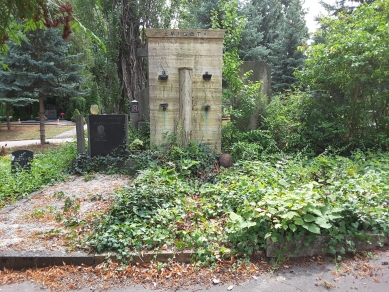
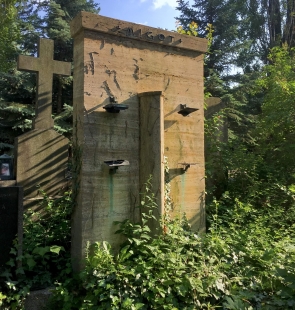
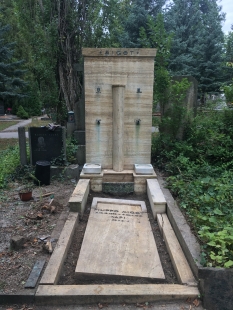
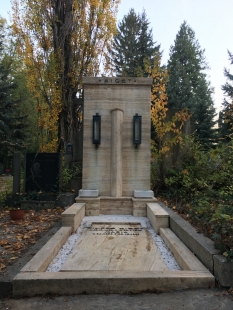
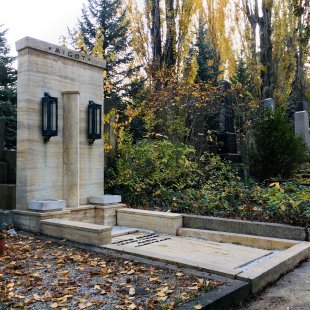
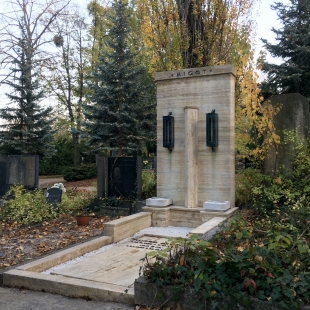
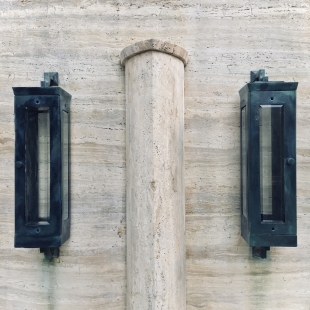
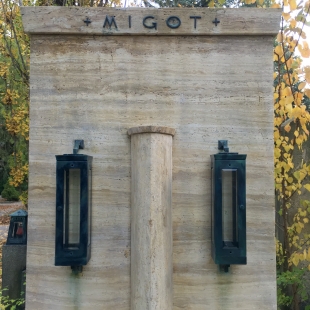
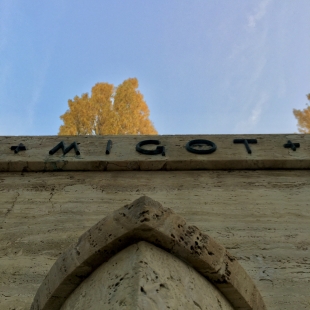
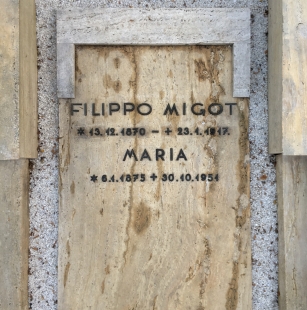
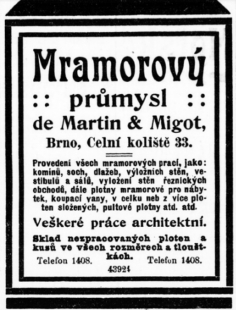
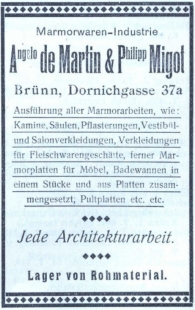
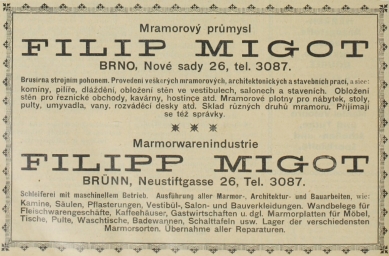
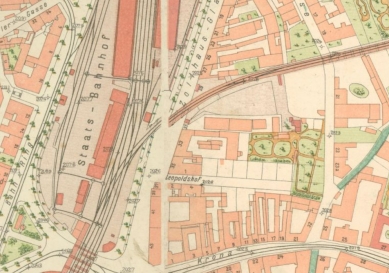
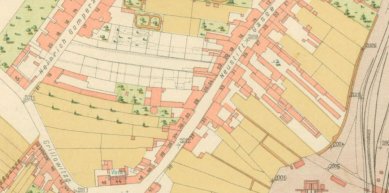
0 comments
add comment










